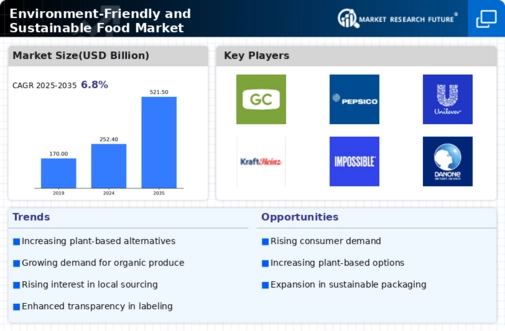Growing Consumer Awareness
Consumer awareness regarding environmental issues appears to be a driving force in the Environment-Friendly and Sustainable Food Market. As individuals become more informed about the impact of food production on climate change, biodiversity, and health, they increasingly seek products that align with their values. Surveys indicate that a significant percentage of consumers are willing to pay a premium for sustainable food options, suggesting a shift in purchasing behavior. This trend is further supported by the rise of social media, where information about sustainable practices spreads rapidly. Consequently, brands that prioritize sustainability in their offerings are likely to gain a competitive edge, as consumers gravitate towards products that reflect their commitment to environmental stewardship.
Rise of Ethical Consumerism
The rise of ethical consumerism is a pivotal driver in the Environment-Friendly and Sustainable Food Market. Consumers are increasingly making purchasing decisions based on ethical considerations, such as animal welfare, fair trade, and environmental sustainability. This shift is reflected in the growing popularity of certifications like organic, fair trade, and cruelty-free, which signal a commitment to ethical practices. Market data suggests that products bearing these certifications often command higher prices, indicating that consumers are willing to invest in products that align with their ethical values. As this trend continues to gain momentum, it is likely to reshape the food industry, pushing more brands to adopt sustainable and ethical practices in their operations.
Shift Towards Local Sourcing
The shift towards local sourcing is emerging as a significant trend within the Environment-Friendly and Sustainable Food Market. Consumers are increasingly interested in purchasing food that is locally produced, as it is perceived to have a lower carbon footprint compared to imported goods. This trend is fostering the growth of farmers' markets and community-supported agriculture programs, which promote direct relationships between consumers and producers. Additionally, local sourcing supports regional economies and reduces transportation-related emissions. As awareness of the benefits of local food systems continues to grow, it is likely that more consumers will prioritize local products, thereby enhancing the demand for sustainable food options.
Government Regulations and Policies
Government regulations and policies play a crucial role in shaping the Environment-Friendly and Sustainable Food Market. Many countries are implementing stricter regulations aimed at reducing carbon emissions and promoting sustainable agricultural practices. For instance, initiatives that incentivize organic farming and penalize unsustainable practices are becoming more prevalent. These regulations not only encourage producers to adopt environmentally friendly methods but also enhance consumer confidence in sustainable food products. As a result, the market for sustainable foods is expected to expand, driven by both compliance with regulations and the growing demand for eco-friendly options. This regulatory landscape may lead to increased investment in sustainable technologies and practices within the food industry.
Technological Advancements in Agriculture
Technological advancements in agriculture are significantly influencing the Environment-Friendly and Sustainable Food Market. Innovations such as precision farming, vertical farming, and biotechnology are enabling producers to optimize resource use and minimize waste. For example, precision agriculture utilizes data analytics to enhance crop yields while reducing the need for chemical inputs. This not only benefits the environment but also meets the rising demand for sustainable food products. The integration of technology in farming practices is likely to lead to more efficient production systems, thereby supporting the growth of the sustainable food market. As these technologies become more accessible, they may further drive the adoption of sustainable practices among farmers.


















Leave a Comment